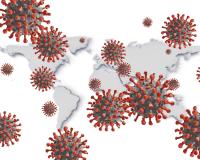
Vibrant Environment
Environmental Justice
All | Biodiversity | Climate Change and Sustainability | Environmental Justice | Governance and Rule of Law | Land Use and Natural Resources | Oceans and Coasts | Pollution Control

Pandemics are global in nature, but their impacts are anything but uniform. COVID-19 is exposing substantial inequities, including disproportionate health and economic consequences for minorities. From medical care to broadband, different demographics have vastly different access to critical resources in a widespread crisis. Indian country is especially hard hit by coronavirus. It is the locus where matters of public health, Indigenous sovereignty, and environmental justice collide. Access to clean, safe, and affordable water offers a particularly stark example. Without water, even following the common sense admonition to frequently wash one’s hands becomes an insurmountable challenge.

If you have walked across downtown Manhattan recently, you may have been blinded by the new colorful green pavement marking protected bike lanes. NYC is one of many cities flaunting their new bike safety initiatives in political speeches, tourist brochures, and subway ads. Given the multiple economic, health, and environmental benefits of replacing car trips with bike trips, their pride is well-deserved. But in order for such initiatives to serve all New Yorkers, they must go a step further.


The COVID-19 pandemic is bringing to light many intersectional divides in the United States that mainstream society can no longer ignore. Lovinia Reynold’s blog last week looked at how environmental racism is linked to higher COVID-19 mortality rates among Black communities.

Black people are bearing the brunt of COVID-19’s impact. Cities such as the District of Columbia, Milwaukee, and St. Louis and states such as Illinois, Louisiana, Michigan, and Mississippi have released data demonstrating that Black people make up a disproportionate number of COVID-19-related deaths. These deaths are due in no small part to centuries of structural inequality that limit access to what public health experts call the social determinants of health.

With the 50th Anniversary of Earth Day still on our minds, air quality is thriving throughout the United States’ most populous areas. It is a goal long fought for by leaders in environmental law and policy, but it has only been achieved with the cost of the devastating COVID-19 pandemic.

In “Animal Agriculture Liability for Climatic Nuisance: A Path Forward for Climate Change Litigation?,” Prof. Daniel E. Walters lays out a new path for climate litigation: environmental litigators should bring federal public nuisance suits to remedy environmental harms caused by animal agriculture.

Drinking water contamination in Flint, Michigan, has garnered nationwide attention, but it is neither isolated, nor a primarily urban problem. As Madeline Kane explains in the April issue of ELR—The Environmental Law Reporter, a hidden water crisis is straining thousands of smaller communities that share Flint’s risk factors—shrinking populations, social marginalization, and deficient funds.

It is now half a century since the first Earth Day. Not only did I help run our school’s “teach in” in 1970, it is also 50 years since my entrance into environmental journalism. A first-person history may help to affirm the importance of the environmental protections that soon followed, as well as of a robust student press to push today’s issues.

Over the past few years, considerable energy has been devoted toward advancing environmental justice (EJ) at the state level. State agencies can be robust laboratories for experimenting with ways to advance EJ, as they’re often tasked with making decisions under state and federal environmental law. As EJ pioneer Charles Lee explains in the March issue of ELR—The Environmental Law Reporter, state lessons can cross-fertilize and inform work at other levels of government, and the role of nongovernmental players is also critical to driving transformative change. Lee believes it is essential that those working to advance EJ systemically expand their discourse.